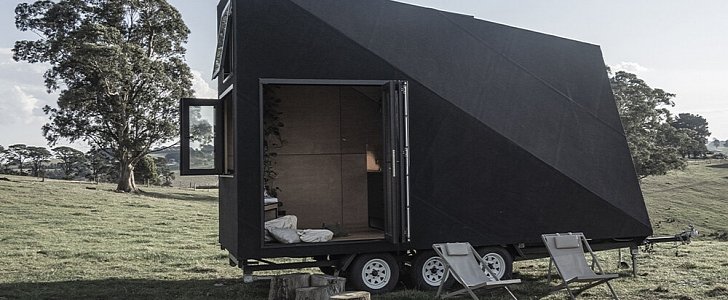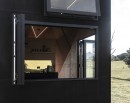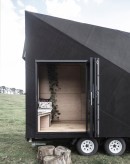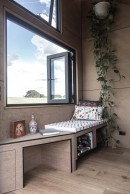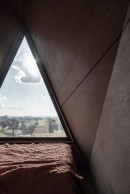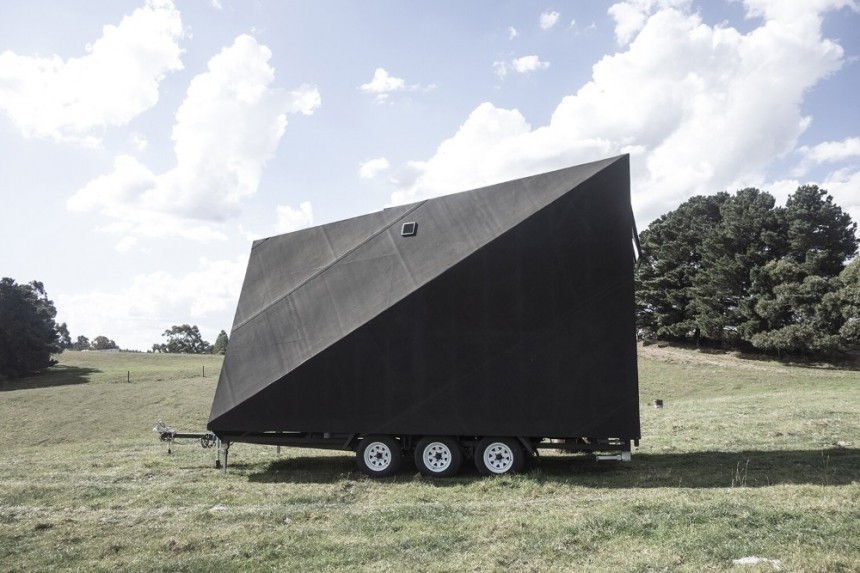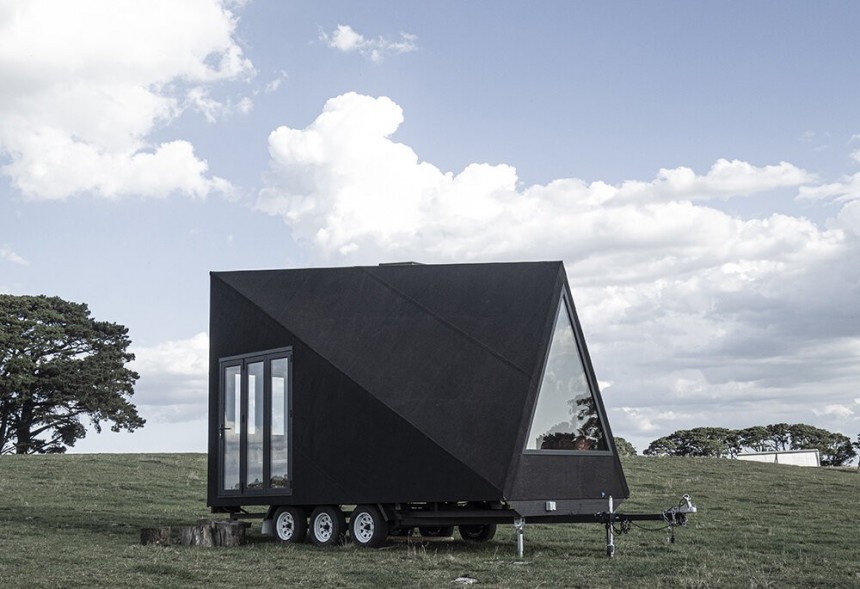There’s been an undeniable surge in interest for micro and mobile homes. Given the high rates for real estate and a concerned focus on cutting down pollution and unnecessary expenses, it’s no wonder that people are turning their attention to tiny houses that can be easily transported from one location to another.
The idea of being able to pack up your house and take it with you whenever you decide to move to another place or even another country is a very appealing one. The same goes for the promise of all creature comforts (and even some luxury), in a space considerably smaller than what we’re (probably) used to in our current, brick-and-mortar homes and apartments.
Add to this the promise of a more sustainable, more efficient, less costly and more in touch with nature lifestyle, and you can see why a certain segment of the population is drawn to mobile homes. Base Cabin, from Australian maker of the same name, hopes to capitalize on this trend, with a new custom micro home on wheels.
The Base Cabin is the creation of British architect Ben Edwards of Studio Edwards and, while it bears a certain resemblance to the Sandcrawler from Star Wars, it’s supposedly directly influenced by the exterior of Airstream trailer and the geometry of the iconic A-frame cabin. The Base Cabin aims to deliver minimalist living with a small footprint, enhanced connection to Mother Nature and some of the comforts of a larger home.
It also aims to compensate for the lack of space through movability. Designed from the get-go with the possibility of being wheeled around according to the owner’s desire, it stands out for the asymmetric geometry and the fact that it’s all black. It’s covered in rubber because, Edwards explains, only rubber could cover all angular faces, be durable enough and offer waterproof qualities. Airstream trailers also come with distinctive exteriors and a streamlined shape (though they’re polished aluminum).
The Base Cabin’s resemblance to the A-frame cabin is more readily apparent: by using asymmetry, this micro home remains easily transportable but without compromising on interior space. By choosing differently-sized angular shapes, Edwards also ensures a clear avoidance of the boxy design of most trailers and micro / tiny / mobile homes.
The design also makes sense from an efficiency perspective. “The A-frame uses less material than conventional portal framed buildings,” he says. “This was an important consideration in regards to the overall mass of the building – it had to be transportable.”
The Base Cabin is divided into three main living areas, with plenty of space for each. Total interior space is over 160 square feet (14.8 square meters): there’s a sleeping area with a large-size bed, a bathroom in the center of the unit next to a cooking area, and a relaxation space.
The bathroom includes a shower pod, sink and toilet, and the kitchen has sink, fridge, cooking top and cabinets for storage space. The relaxation space is limited to an oversize window ledge with storage space underneath. From renderings available online, this seems to be the only storage space available throughout the cabin.
There are large windows on all sides, including a skylight above the bed and another one in the bathroom. Doors are also made of glass panels, so the space is always bathed in natural light, which enhances the feeling of “one with nature” that comes with a mobile home. Meanwhile, the sloped walls create a sense of intimacy.
By emphasizing the fact that a micro, mobile home allows you to go off the grid and back into Mother Nature’s loving arms, and the use of alternative building materials, there is strong indication that the Base Cabin is built with a focus on sustainability. This, if accurate, would be great – and add to the appeal of this quirky-shaped house on wheels.
However, there is no mention of energy consumption needed to run this house, towing capacity of the parent vehicle, or any other type of resource needed to live like in an actual home. The availability of so little storage space could also indicate that this is more of a vehicle for short-term adventures than an actual micro home fit for long-term living – on or off the grid.
Pricing for the Base Cabin starts at AUD $99,000 (USD $65,000) and the makers say they’re open to all queries. They also emphasize that, “Whilst the cabins we build are small in size, we seek out the best finishes to incorporate them into our spaces. We believe in quality over quantity.” For what it’s worth.
Add to this the promise of a more sustainable, more efficient, less costly and more in touch with nature lifestyle, and you can see why a certain segment of the population is drawn to mobile homes. Base Cabin, from Australian maker of the same name, hopes to capitalize on this trend, with a new custom micro home on wheels.
The Base Cabin is the creation of British architect Ben Edwards of Studio Edwards and, while it bears a certain resemblance to the Sandcrawler from Star Wars, it’s supposedly directly influenced by the exterior of Airstream trailer and the geometry of the iconic A-frame cabin. The Base Cabin aims to deliver minimalist living with a small footprint, enhanced connection to Mother Nature and some of the comforts of a larger home.
The Base Cabin’s resemblance to the A-frame cabin is more readily apparent: by using asymmetry, this micro home remains easily transportable but without compromising on interior space. By choosing differently-sized angular shapes, Edwards also ensures a clear avoidance of the boxy design of most trailers and micro / tiny / mobile homes.
The design also makes sense from an efficiency perspective. “The A-frame uses less material than conventional portal framed buildings,” he says. “This was an important consideration in regards to the overall mass of the building – it had to be transportable.”
The Base Cabin is divided into three main living areas, with plenty of space for each. Total interior space is over 160 square feet (14.8 square meters): there’s a sleeping area with a large-size bed, a bathroom in the center of the unit next to a cooking area, and a relaxation space.
There are large windows on all sides, including a skylight above the bed and another one in the bathroom. Doors are also made of glass panels, so the space is always bathed in natural light, which enhances the feeling of “one with nature” that comes with a mobile home. Meanwhile, the sloped walls create a sense of intimacy.
By emphasizing the fact that a micro, mobile home allows you to go off the grid and back into Mother Nature’s loving arms, and the use of alternative building materials, there is strong indication that the Base Cabin is built with a focus on sustainability. This, if accurate, would be great – and add to the appeal of this quirky-shaped house on wheels.
However, there is no mention of energy consumption needed to run this house, towing capacity of the parent vehicle, or any other type of resource needed to live like in an actual home. The availability of so little storage space could also indicate that this is more of a vehicle for short-term adventures than an actual micro home fit for long-term living – on or off the grid.
Pricing for the Base Cabin starts at AUD $99,000 (USD $65,000) and the makers say they’re open to all queries. They also emphasize that, “Whilst the cabins we build are small in size, we seek out the best finishes to incorporate them into our spaces. We believe in quality over quantity.” For what it’s worth.
